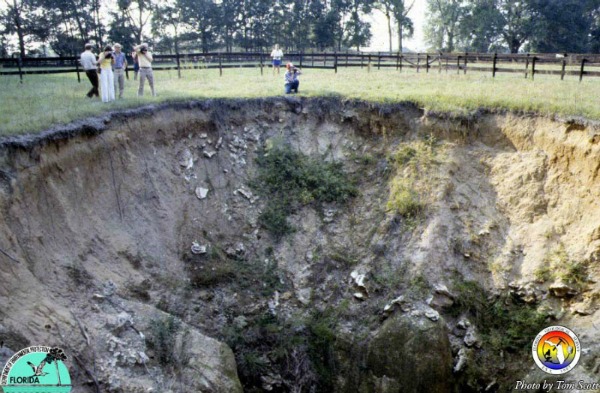Florida man swallowed up by sinkhole

A Tampa, Florida man was swallowed up by a sinkhole when his bedroom collapsed on the last day of February 2013. The hole is 30 feet wide and 20 feet deep. Sound and video equipment lowered into the hole detected no signs of life. The man in the sinkhole, Jeffrey Bush, is presumed dead. Unfortunately, rescuers can't retrieve him because of the possibility that the hole is still spreading, possibly ready to collapse at any time. But, what is a sinkhole? Why do they appear?
There are three major types of sinkholes.
Solution sinkholes: These form at locations where bedrock (rock salt, limestone, dolomite and marble) is exposed at the surface, subjecting it to weathering and disintegration. Water collects in natural depressions at the surface and slowly dissolves a sinkhole.
Subsidence sinkholes: These are similar to the above solution sinkholes, but the bedrock is covered with a thin layer of soil or sediment. Water infiltrates the bedrock and dissolves it where it is fractured. The overlying soil gradually moves down into the gap as it expands.
Collapse sinkholes: This is the kind of sinkhole that swallowed up Mr. Bush's bedroom. It is the most dangerous type, forming when surface materials suddenly fall into a cavity or cave. The formation of the cavity is usually slow. Groundwater gets into fractures in the bedrock and enlarges them through dissolution. Collapse results when either the roof over the cavity becomes too weak to support the weight of the overlying materials or when groundwater supporting the weight below the surface drops to low levels. This leaves a funnel-shaped hole where the collapse occurs. Human activity that affects the hydrology of an area often play a key role in the development of collapse sinkholes.
These sinkholes are not uncommon, especially in Florida, where thousands of small sinkholes form each year due to the state's geography. There is currently no way to predict when and where a fatal sinkhole will appear. Sinkholes occur all over the world, with the largest being the Qattara Depression in Egypt. In the United States, sinkholes are also common in Kentucky, Michigan and Tennessee.
Below is a picture of a sinkhole on a farm near Ocala, Florida.

Photo of Tampa sinkhole location courtesy of Reuters. Photo of Ocala farm sinkhole courtesy of Tom Scott and the Florida Department of Environmental Protection.
8 comments